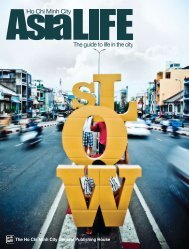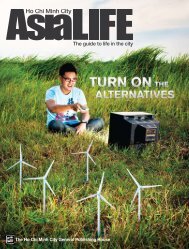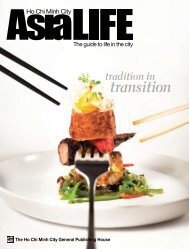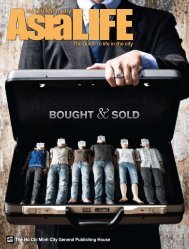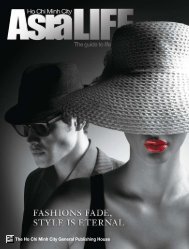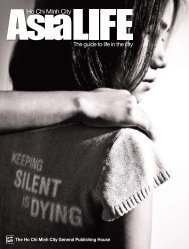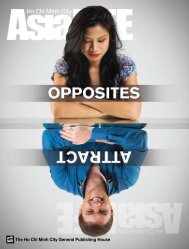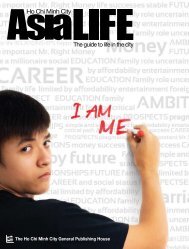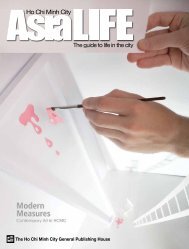asialife HCMC 1 - AsiaLIFE Magazine
asialife HCMC 1 - AsiaLIFE Magazine
asialife HCMC 1 - AsiaLIFE Magazine
You also want an ePaper? Increase the reach of your titles
YUMPU automatically turns print PDFs into web optimized ePapers that Google loves.
zunkha-bhakar, rice pancakes<br />
eaten with a hot, polenta-like<br />
gramflour paste, and puribhaji,<br />
fried wheat pancakes with<br />
spicy potatoes, and, of course,<br />
sugarcane juice, sweet, cold,<br />
refreshing and a real treat on a<br />
hot day. Cutting chai, half-full<br />
glasses of thick, sweet, spiced<br />
tea will seal the stomach and<br />
help the digestion. And kulfi,<br />
a creamy frozen treat related<br />
closely to ice-cream, will demand<br />
a return trip. And if you<br />
happen to live and work in the<br />
city, you will very likely use the<br />
dabbawalla service, endorsed by<br />
corporate biggies and lauded<br />
by Prince Charles, and now<br />
considered a model of high-efficiency<br />
networking and business<br />
management. This is run by an<br />
ever-increasing group of men<br />
who bustle from home to office<br />
to home again, delivering lunch<br />
boxes with foolproof speed and<br />
organization.<br />
Perhaps a symbol of Mumbai<br />
is the commuter train system,<br />
which the dabbawallas use to<br />
best effect. The electric-powered<br />
carriages wind their way like<br />
heavy metal worms through<br />
the heart of the city, taking<br />
hordes of professionals from<br />
home to work and back every<br />
day. A ride on one of these<br />
is fascinating, fast, efficient,<br />
exciting, the easiest way to get<br />
from A to B without taking too<br />
long over it and avoiding the<br />
traffic that makes Mumbai such<br />
a nightmare to travel in. There<br />
is always something to see out<br />
the windows—and doors—of<br />
the train; and there is so much<br />
happening inside too, from<br />
card games to prayer sessions<br />
to kitty parties to an occasional<br />
baby birth, a fight, even a death<br />
or two as the unwary dash<br />
across the tracks.<br />
And the train is where much<br />
of Mumbai’s go-getting character<br />
can be seen—there will be<br />
a fisherwoman from the Koli<br />
community sitting by the door,<br />
her ears glinting with heavy<br />
gold and her bejeweled fingers<br />
holding up a brand new, hi-tech<br />
mobile phone to her ear. There<br />
will be an aspiring television<br />
actor learning her lines, patting<br />
her carefully arranged hair into<br />
place, her clothes and makeup<br />
all set to go. There will be an executive<br />
barking orders over the<br />
phone while his fingers scuttle<br />
over the keyboard of his laptop.<br />
And there will always be a<br />
couple staring longingly into<br />
each other’s eyes as they are<br />
pressed together in the crush of<br />
the second-class compartment.<br />
This is the city that never<br />
sleeps, the city of gold, the city<br />
where dreams can come true.<br />
This is Mumbai. As the song<br />
goes, “Yeh hai Mumbai, meri jaan!”<br />
(this is Mumbai, my dear!)<br />
<strong>asialife</strong> <strong>HCMC</strong> 49



